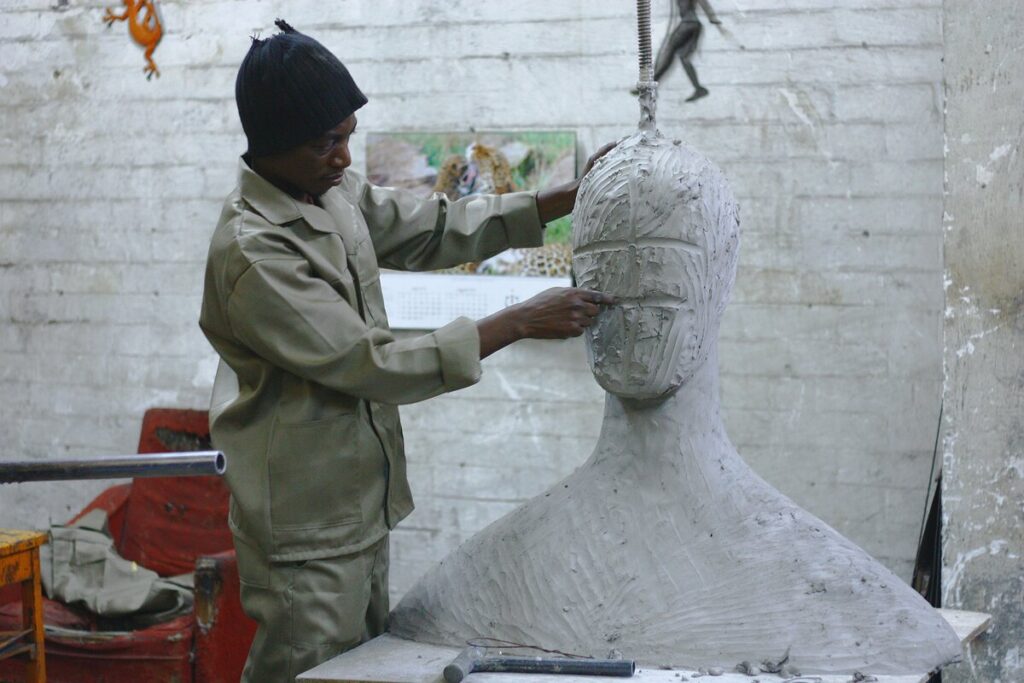Investing in Africa’s Creative Industries: Art, Music, and Entertainment
Africa, a continent rich in artistic tradition and cultural variety, is currently going through a creative industries revival. Africa’s creative industry has developed into a hub of innovation and cultural expression, from the dynamic rhythms of its music to the intricate storytelling woven into its art. The Centre for African Development & Investment promotes strategic investments that not only promote economic progress but also nurture the resilience and vibrancy of Africa’s artistic environment in recognition of the enormous potential of this developing industry.
This article explores the diverse world of Africa’s creative industries, emphasizing the transformational effects of investments in the arts, music, and entertainment as well as its crucial role in determining the socioeconomic destiny of the continent.
The Role of Art in Social Change

Supporting the continent’s vibrant artistic community is essential for keeping its rich cultural history alive. Tribal sculptures, textiles, and pottery are examples of traditional African art that act as essential links to the continent’s history and provide insights into the various stories and historical legacies that shape Africa’s identity.
Investment efforts can aid in the preservation and promotion of Africa’s artistic legacy by developing forums for cultural exchange and supporting local artists, deepening understanding of the continent’s cultural roots on and off the continent.
The African art scene acts as a platform for social commentary and expression, giving voice to underrepresented groups and promoting societal change. The creative sector becomes a catalyst for solving important social concerns including gender equality, environmental sustainability, and human rights through investing in community art projects and programs that encourage artistic freedom and inclusivity.
Investments in Africa’s art industry may spark discussions and mobilize people towards good social development and progress by encouraging artists to use their work as a tool for advocacy.
African Rhythms: Investing in the Music Sector
The music scene in Africa is a kaleidoscope of various genres and styles, each of which reflects the distinctive cultural fabric of the region. The music landscape in Africa is a dynamic celebration of diversity and unity, from the rhythmic pulses of Afrobeat to the heart-stirring melodies of traditional folk music.
Putting money into the music business not only encourages intercultural interaction and trade but also strengthens African communities’ sense of pride and identity on a worldwide scale. Investing in Africa’s Creative industries or music industry is crucial for developing and empowering young musicians by giving them the tools, instruction, and exposure they need to succeed in the cutthroat international music market.
The music industry can foster the growth and development of the following generation of African musical prodigies by establishing music education initiatives, supporting regional music production studios, and planning music festivals and events. This will pave the way for a vibrant and long-lasting music ecosystem.
The Role of Entertainment in Economic Development
In recent years, Africa’s entertainment industry, notably its budding film industry, has seen substantial growth and praise. Investors can help elevate African narratives on a global stage by funding the production and distribution of African films, documentaries, and other visual storytelling projects.
This will help people understand and appreciate the continent’s rich cultural diversity and nuanced storytelling customs better. This not only encourages the growth of the entertainment industry’s economy but also establishes Africa as a center of artistic innovation and excellence in film.
Investments made in the African entertainment sector also support the growth of infrastructure and the adoption of cutting-edge tools and online platforms that improve the creation, accessibility, and distribution of African entertainment content. Investors can help modernize and internationalize Africa’s entertainment industry by supporting initiatives that use technology for content creation and distribution.
This will place Africa as a major player in the world’s digital entertainment market and open up new opportunities for economic growth and cross-border cooperation.
Opportunities and Challenges in Creating a Sustainable Future
The lack of adequate infrastructure is one of the major obstacles facing Africa’s creative industries.
Investment projects that concentrate on constructing cutting-edge music studios, art galleries, and entertainment centers can establish a lively ecosystem that encourages innovation, cooperation, and artistic excellence while providing a favorable climate for artists and industry professionals to thrive.
Promoting Policies and Regulations that Protect the Rights of Artists, Creators, and Industry Stakeholders is Essential to the Long-Term Sustainability and Growth of Africa’s Creative Industries. Investment institutions can advocate for the adoption of laws that support copyright protection, intellectual property rights, and just compensation by working with governmental and regulatory bodies.
This will create a safe and supportive environment for creative professionals to thrive and make contributions to the socioeconomic development of the continent.
Global Market Potential for African Creatives
Africa’s creative industries are poised for a remarkable leap onto the global stage, with an array of products and services that showcase the continent’s rich cultural tapestry and innovative spirit. From visual arts and music to film, fashion, literature, and digital media, African creators are capturing the world’s attention, and their work is finding resonance far beyond the continent’s borders.
Africa’s creative sector has experienced a renaissance in recent years, as artists, designers, musicians, and filmmakers draw inspiration from their diverse cultural backgrounds and reinterpret them in contemporary contexts. This fusion of tradition and modernity results in creations that are not only visually stunning or sonically captivating but also carry a powerful narrative that resonates globally.
Pioneers of African Creativity
Several African artists and creators have emerged as trailblazers, garnering international acclaim and recognition for their contributions to the global creative landscape:
- El Anatsui (Nigeria): Renowned for his awe-inspiring metal sculptures, El Anatsui’s work has been exhibited in prestigious museums and galleries around the world. His unique approach to repurposing discarded materials into breathtaking tapestries has earned him a place among the most influential contemporary artists globally.
- Burna Boy (Nigeria): This Afrobeat sensation has taken the music world by storm with his genre-defying sound and socially conscious lyrics. With chart-topping hits and collaborations with international artists, Burna Boy has become a powerful ambassador for African music on the global stage.
- Lupita Nyong’o (Kenya): An Academy Award-winning actress, Lupita Nyong’o has captivated audiences with her exceptional talent and versatility. Her performances in acclaimed films have earned her widespread recognition and a platform to advocate for inclusivity and representation in Hollywood.
- Wangechi Mutu (Kenya): A visual artist known for her thought-provoking collages and sculptures, Wangechi Mutu’s work challenges conventional notions of beauty, identity, and gender. Her exhibitions in major art institutions worldwide have sparked critical conversations about African art in the global context.
A Culture Of Creativity and Innovation Through Education
The support of the arts and cultural education work hand in hand with investments in Africa’s creative industries. Investing in African creative industries can foster a culture of creativity and innovation from a young age, fostering a generation of people who appreciate and contribute to the richness of Africa’s artistic heritage. This can be done by advocating for the integration of creative arts into formal education curricula, supporting vocational training programs, and establishing art scholarships.
Furthermore, stakeholders can lay the groundwork for a thriving ecosystem that values and supports the transformative power of the arts in forming Africa’s socio-cultural narrative by investing in educational institutions, cultural hubs, and art academies. By doing this, stakeholders can foster an environment that encourages artistic exploration, critical thinking, and creative expression.
Sustainable Partnerships: Working Together for Long-Lasting Results

The development of long-lasting alliances that encourage creativity, resource sharing, and collaborative growth is essential for the success of Africa’s creative industries. Investments can build a synergistic ecosystem that promotes creativity, supports innovation, and propels sustainable development through encouraging cooperation between private investors, governmental entities, non-profit organizations, and local communities.
Strategic partnerships enable stakeholders to make the most of their combined knowledge, networks, and resources to tackle pressing issues, carry out significant projects, and create a solid foundation for the long-term sustainability and resilience of Africa’s creative industries, ensuring that they continue to grow and thrive in the face of changing global dynamics and economic difficulties.
Fostering talent and creativity through youth empowerment and employment
The empowerment of youth and the provision of job possibilities are two important effects of investment in Africa’s creative industries. Investments can foster a new generation of creative professionals by directing resources into youth-focused art education programs, vocational training initiatives, and mentorship platforms.
This will create a pool of talented people who are prepared to thrive in the dynamic creative landscape. The growth of the creative industries also creates employment opportunities in a variety of fields, such as music production, film direction, event management, and arts administration, which supports inclusive development and socioeconomic empowerment of communities across the continent.
Conclusion
Investing in Africa’s creative industries is a way to support the continent’s artistic and cultural heritage as well as its economic development. In the future, according to the Centre for African Development & Investment, Africa’s artistic scene will flourish as a symbol of innovation, resiliency, socioeconomic development, and financial prosperity.
The Centre is dedicated to maximizing the potential of investing in Africa’s Creative industries and positioning them as engines of sustainable development, cultural diplomacy, and international artistic excellence. To this end, it cultivates strategic partnerships, advocates for policy reforms, and directs resources toward the development of the continent’s art, music, and entertainment sectors. Along with the creative industry, we support investors in the UAE to invest in Africa’s several other industries.
Join us and let’s set out on a journey together that honors Africa’s artistic prowess and moves the continent closer to a future of prosperity and artistic greatness.
FAQ’s
- What are the main facets of the creative industries in Africa?
Ans- A diverse tapestry of artistic expression, including visual arts, performing arts, music, film, fashion, literature, and digital media, makes up Africa’s creative industries. Together, these elements display the cultural richness of the continent and represent a talent and innovation pool with regional and global appeal.
- How are Africa’s creative industries impacted by its rich cultural heritage?
Ans- The creative industries of Africa are profoundly inspired by the continent’s rich cultural legacy. A distinctive fusion of authenticity and originality is infused into a variety of creative endeavors by the continent’s different customs, folklore, rituals, and historical narratives.
- What part does the creative sector play in the economic growth of Africa?
Ans- Africa’s creative sector makes a substantial contribution to the continent’s economic growth. It promotes cultural tourism, encourages entrepreneurship, draws foreign investment, and creates employment possibilities, supporting regional economic growth and sustainability.
- In what ways may financial support for Africa’s creative sectors promote social empowerment?
Ans- By giving marginalized communities and individuals a platform to display their abilities, tell their experiences, and take part in the socioeconomic growth of their respective societies, investment in Africa’s creative industries can support social empowerment. It promotes inclusivity, diversity, and self-determination within local communities.
- What opportunities and obstacles do investors in Africa’s creative industries face?
Ans- The creative industries in Africa offer promising investment potential, but they also confront obstacles like a lack of capital, poor infrastructure, and problems with intellectual property rights. However, investors can profit from the continent’s developing creative industries with the appropriate strategic alliances, regulations, and financial assistance, tapping into a market with enormous untapped potential and rising global demand for African cultural goods and experiences.
- How might technology help the creative industries in Africa expand?
Ans- The production, distribution, and consumption of artistic content could be revolutionized by the incorporation of technology into Africa’s creative sectors. It offers a platform for Internet marketing, worldwide outreach, and digital innovation, thereby extending its reach.
- What initiatives can be undertaken to promote the export of Africa’s creative products internationally?
Ans- Initiatives like cultural exchange programs, participation in international festivals and exhibitions, strategic alliances with international distributors, and the creation of cultural export promotion agencies can all play a significant role in promoting the export of Africa’s creative products internationally and showcasing the continent’s diverse artistic talent while fostering international collaborations and trade relations.
- How does the sustainability of Africa’s creative industries benefit from the preservation of traditional art forms?
Ans- The authenticity and cultural integrity of Africa’s creative industries depend on the preservation of traditional art forms. By maintaining indigenous art forms, Africa can maintain its distinctive character, foster intergenerational cultural interchange, and encourage current artists to draw inspiration from their cultural roots, assuring the continuity and longevity of the continent’s creative legacy.
- What regulations may be put in place by governments to encourage the expansion of Africa’s creative industries?
Ans- Governments can put in place laws protecting intellectual property, establishing tax incentives for creative businesses, facilitating access to funding and financial resources, and promoting education and training initiatives that are specifically geared toward the needs of the creative industry. A favorable environment for the long-term development of Africa’s creative industries can also be produced by encouraging cooperation between the public and private sectors.





